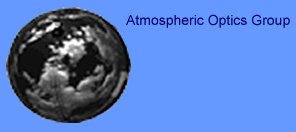
 |
| |
|
|
|
|
|
|
|
Field Calibration DeviceDue to the remote siting of several of the WSI instruments, it is often not practical to return them to MPL for radiometric calibration. For this reason, a field calibration device had been developed to enable full calibration in the field. Because differing systems require slightly different calibrations, this particular device was generated for a specific version of the WSI, but could be modified for other versions. The Absolute Radiance device is shown in the figure below. The top piece is a Labsphere URS 600 Uniform Radiance Standard, calibrated for absolute spectral radiance. It includes a 6” integrating sphere, and an adjustable slide attenuator, which allows one to adjust the flux entering the sphere (without affecting the color temperature of the lamp). The lamp is controlled with a DC constant current regulated power supply. The output of the sphere is monitored by a solid state photopic photodetector, so that changes due to the aperture setting, as well as changes due to the temperature, lamp age, or other environmental factors, may be adjusted for. The lower piece in the illustration is the mating device that attaches the URS to the WSI. It includes a 3 log neutral density filter which is positioned with a filter holder and may be manually brought in and out of the optical path by the user. The absolute radiance device is used for measuring the linearity, shutter effective opening time, absolute radiance response, and optical dome calibration. The Uniformity Device (shown below) is a white hemisphere coated with Spectraflect, with a lamp and baffle. It is mounted on the WSI and images are acquired over a set of rotational angles. The inside of the hemisphere has been mapped for relative radiance. The half of each image which does not include the lamp and baffle is corrected for the device relative radiance, and then these half images are combined to yield an image of the system non-uniformity. This non-uniformity includes the lens rolloff (the decrease in sensitivity as a function of zenith angle caused by the changing solid angle per pixel and by vignetting) as well as pixel-to-pixel effects such as the non-uniformity of the fiber optic taper in the camera.
An interactive field calibration program guides the user through the calibration data acquisition, and an IDL program processes the acquired calibration data and provides calibration results for use in calibrating field data.
Produced
by the Marine Physical Laboratory, SIO.
|